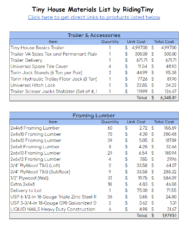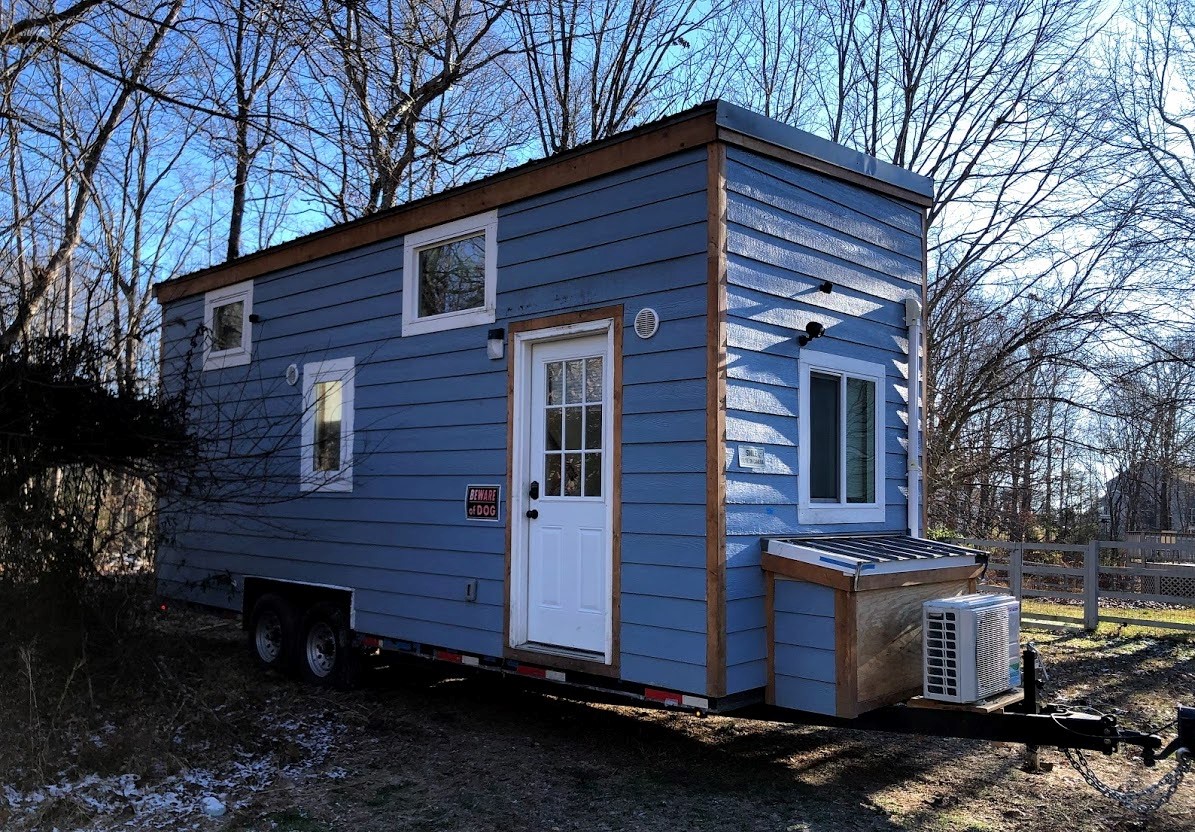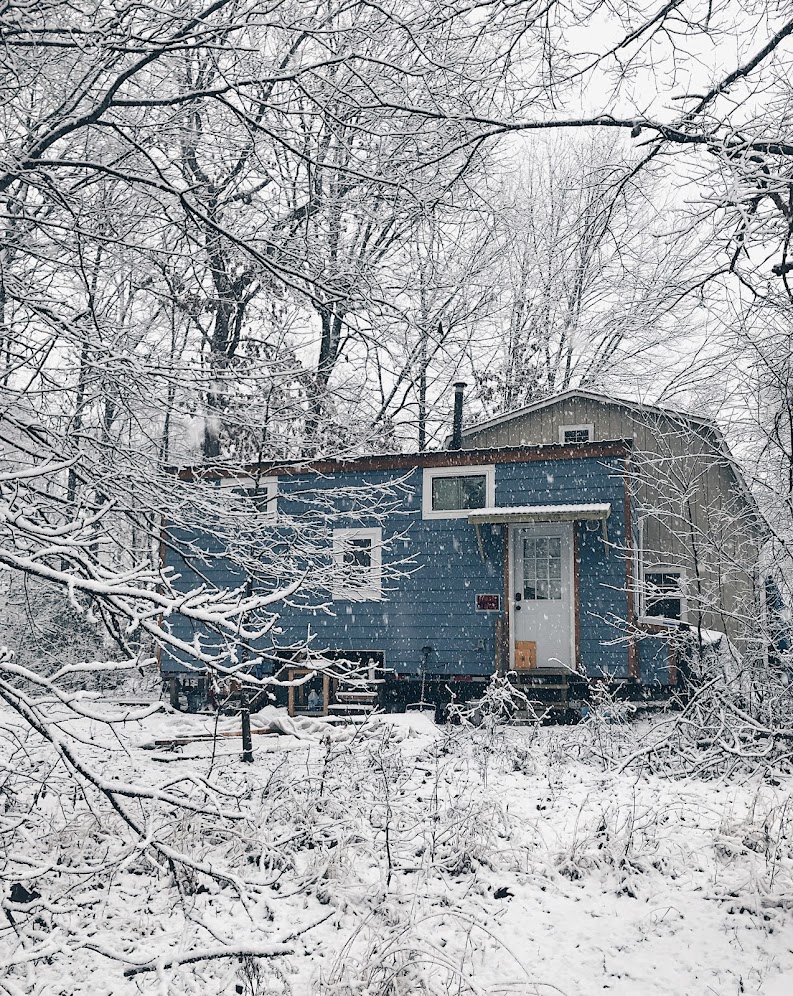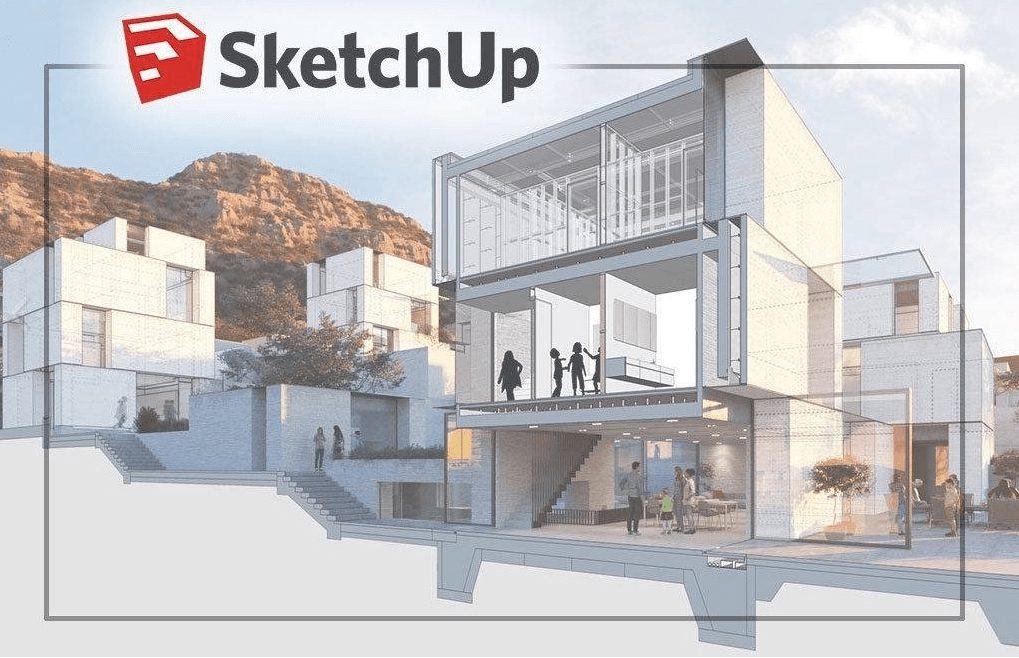Taking time to plan and design your tiny home can save you big bucks on your build, plus let you get to customize however you please.

By entering your email address you agree to receive emails from Riding Tiny. We’ll respect your privacy and you can unsubscribe at any time.
How to Build a Tiny House Step-by-Step: A Complete Guide
- By Sang Kim
- Updated:

Have you ever wanted to learn how to build a tiny house step by step? Then, you are in the right place!
Building a THOW is easy, with proper guidance. Here are the exact steps I took to build my 24′ tiny house on wheels from start to finish with zero construction experience.
Table of Contents
Introduction
There’s tons of information scattered out there on building a THOW – guides, videos, books, tutorials, and an awful lot of tiny home tours, etc.
However, for people starting their tiny home build journey with little to no building experience, it is easy to get lost and give up before even starting the project.
So, I wanted to make everyone’s life super easy by making a simple, easy-to-follow, step-by-step guide that includes all the resources I used and the steps I took to build my 24′ x 8’5″ THOW.
A little bit about RidingTiny
Hey! Sang here. Back in 2018, I was tired of shelling out thousands of dollars in rent every month. I thought there has to be another way.
So long story short, later that year, I spent the next 5 months planning and building my 24′ THOW from scratch! I named my tiny home @RidingTiny and I’ve been living in it ever since.
During the build process, I taught myself everything that I needed to know, including framing, electrical, plumbing, roofing, installing a mini-split, fixtures, etc.
- Tiny House Materials List by RidingTiny
- How We Saved $11,000 on Tiny House Build Costs
- More Pictures of RidingTiny
Now, there’s tons of information scattered out there on building a THOW – guides, videos, books, tutorials, and an awful lot of tiny home tours. Because of this, it is easy to get overwhelmed and many people give up before even starting the project.
So, I wanted to make everyone’s life super easy by making a simple, easy-to-follow, step-by-step guide that includes all the resources I used and the steps I took to build my tiny house on wheels, even if you have no experience!


How to Build a Tiny House: Planning Tiny
So you want to learn how to build a tiny house on wheels, but how do you get started?
A successful tiny home build goes through two major phases: planning your tiny and building your tiny. If you already finished planning your build or currently building your tiny, then skip straight to How to Build a Tiny House: Building Tiny.
This section is for people who are thinking about and planning on building a tiny home.
How much to build a tiny house on wheels?
Before you even think about building a tiny house, you have to make sure you have enough finances to cover building costs.
So how do you know how much to save for building a tiny house? Well, it costs $30,000 to build a brand new 24ft tiny house from scratch. You can build it for even cheaper by following the guides below.
Learn how to use SketchUp


SketchUp is a tool that allows you to digitally design, visualize, and modify any structure – in our case: a tiny home. In a couple of hours, you can bring your ideas to life.
Folks at Tiny Nest have a SketchUp tutorial that teaches you everything you need to know when it comes to designing a tiny home.
I believe the tutorial is only $30. Worth every penny.
SketchUp is a paid tool but you can get a free 2017 make version. This is the version I used for my tiny and has more than enough features. Getting the paid version isn’t necessary.
Once you learn SketchUp, play around with it. You can either design your tiny home from scratch or buy a tiny house plan online and recreate & modify it on SketchUp.
Here’s a YouTube playlist of Michael Janzen, from TinyHouseDesign, designing a tiny home from scratch on SketchUp.
Educate yourself on construction basics
Now, you just learned SketchUp. But how the hell do I know if the home I designed is structurally sound?
First, learn the overall process of building a tiny home by watching other people build their tiny.
Once you see a preview of the overall process of building a tiny home, you will feel more confident going into it.
Here are my favorite building series I recommend you watch:
Then, learn about the basics of framing and load distribution.
- Tiny House Framing and Sheathing – The Complete Guide
- Wood Stud Framing
- Framing Rough Openings
- Tiny House Design & Construction Guide
Roofing, electrical, and plumbing can be learned as you build. More on that later.
Design your tiny home on wheels
If you’ve never built anything before in your life, I advise you to keep your design as simple as possible.
- Go with a simple roof design. I’m talking about a gable roof or a shed roof. Less complexity means cheaper & easier to source, build, and maintain.
- Keep your windows to a minimum. Having lots of windows looks cool, but windows are EXPENSIVE and make the house THERMALLY INEFFICIENT. Only install windows where you need them.
- Try tiny house living. Go to tiny house festivals. Live in a tiny home AirBnB around your area for a couple of days. Jot down what you like and didn’t like about your experience and incorporate them into your design. Tiny House Festivals Dates – Tiny Living
- View tiny house tours on Youtube. Check out what others have done with their tiny home. Find the features you like, incorporate them into your design. Here are my two favorite tiny house tour channels:
Find a place to build
If you live in a neighborhood that has an HOA. You can’t build there. That is a hard no-no.
So if you are like me, who lived in a townhome without any additional building space. Try the following options.
- Ask around. Maybe you know friends, family, or acquaintances who may have a lot for you to build your tiny on.
- Post a Craigslist ad. Tell a potential landlord what exactly what you are looking for. A lot that is big enough to park your tiny and build your tiny.
- Facebook marketplace. Search “parking spot” or “land for rent”. Some owners might not have thought about renting it out to potential tiny builders. You may even have to explain to the landlord what a THOW is.
- Facebook Ads. You can pay to have an ad run on Facebook that will target certain age groups, regions, and income levels to help find your parking space. Set a budget. Run ads. It works.
How to Build a Tiny House: Building Tiny
Once you settled on your tiny home design and found a place to build, it’s time to create your materials list and start building.
To build your materials list, simply count up the number of studs, joists, roofing panels, sheathing, amount of insulation, appliances, windows & doors, fixtures, etc you’ll need based on your tiny house plan you either designed or purchased.
Then, look up the pricing and quantity of the materials you intend to purchase and include them in your materials list.
- Tiny House Materials List- Direct links to tools and materials
- Tiny House Materials List – 24′ THOW (Including quantity and price)
By doing this, you can get a pretty close estimate of your actual build costs.
So that is out of the way, let’s start building! Here are ALL the tasks you must complete in the following order.
Buy a tiny house trailer
Find a trailer manufacturer near you that sells custom tiny home trailers. (Google is your best friend).
Unless you have prior experience with fixing up used trailers, I recommend buying a new trailer designed specifically for tiny homes.
Now, when ordering a tiny house trailer, I HIGHLY recommend getting square fenders and undercarriage flashing options from the manufacturer if they provide them.
These additional add-ons will cost an extra couple of hundreds of dollars but they will save you tons of time, money, and energy.
Having these pre-installed makes your job easy because you only have to insulate the subfloor and install subfloor sheathing directly onto the trailer.
Here are the well-known trailer manufacturers that I recommend you start your research from:
Make arrangements with the manufacturer to have it shipped to your building spot.
Level your tiny house trailer
Once the trailer arrives, level it.
Insulate your tiny house foundation
Insulate your foundation with R-23 Rockwool insulation (the most cost-effective, DIY-friendly option) or the insulation that fits into the foundation.
Wall, roof, and subfloor insulation:
If you plan on framing your own foundation, this is a good resource:
Install subfloor sheathing
Use 3/4″ T&G plywood or OSB.
Leave 1/8″ gaps between all boards for expansion. Fasten the board to the trailer using self-drilling metal-to-wood screws.
Frame the wall sections
Frame the walls into sections that can later be raised by you and your helpers (family, friends, even neighbors). Frame them, and square them.
Raise and secure the wall sections
Raise the walls one at a time. Once the walls are raised and plumbed, prevent the walls from moving by crossbracing the wall sections.
Kind of like this: Securing the Walls. Now, if your trailer comes with pre-welded bolts, secure them using Simpson Strong ties.
Otherwise, you can drill 1/2″ holes through the bottom plate, subfloor, and trailer deck, and use a combination of nuts, bolts, washers, and Simpson strong ties to secure the wall sections to the trailer frame.
- Raising the tiny house walls – Handeeman
- How to secure the wall framing of your tiny house to the trailer using threaded rods
- How to Build and Frame Tiny House Walls: Ana White Tiny House Build [Episode 3]
Once the walls are raised and secured, you’ll notice that it is still “wobbly”. Don’t worry. The walls will become rock solid once the wall sheathing and roof are assembled.
Install the lofts
There are plenty of loft designs out there. No need to reinvent the wheel. Pick one and move on!
Install the loft sheathing
Use 3/4″ plywood or OSB for loft sheathing. Use as many whole pieces of sheathing as you can to reduce waste and save money.
Having a loft built early in the building process enables you to install roof rafters with ease. Fasten the same way as you did in subfloor sheathing.
Install the roof rafters
Pre-cut your rafters based on your roof design. For most tiny homes, 2×6 roof rafters will be enough for most use cases.
Depending on your design & insulation choice, your roof may or may not need to be vented. Do your research and build accordingly.
Install wall & roof sheathing
Use 1/2″ Plywood/OSB to sheath your walls and 3/4″ for the roof. Use as many whole pieces as possible and stagger them for extra racking strength.
After sheathing the walls and the roof completely, cut the sheathing to allow for any openings, such as windows and door(s).
Install housewrap (wall) and tar-paper (roof)
Housewrap is a weather-resistant barrier that shields your home from rain, air, and moisture infiltration. It helps your home dry as you work towards the interior of your house.
Housewrap is installed in between the exterior siding and the wall sheathing. Tar-paper/roofing-felt/roofing underlayment goes on top of your roof sheathing but below your roofing material. Similarly, it acts as a moisture-resistant barrier.
Install windows and doors
Door and window installations are straightforward. But always follow the installation instructions provided by the window manufacturer.
Once your windows and doors are in, you’re pretty much “dried-in”.
Install the roof
For tiny homes, metal roofing is the most optimal choice. It’s expensive but it lasts 50+ years, is highly energy-efficient, and makes your house look super sleek!
You can order basic, classic rib-style metal roofing from Lowe’s and Home Depot if you are going for a budget option.
But if your roofing design is more complex (although not recommended) and requires additional hardware and roofing parts, then I would suggest paying a visit to your local roofing companies to get some quotes for your roof.
Before you work on your roof, make sure to install the fascia boards and do necessary prep work (as required by the manufacturer) for proper installation.
Install exterior siding and trims
There are multiple siding options to choose from: wood, metal, engineered wood, etc.
I went with LP SmartSide siding. It is an engineered wood product that has wood texture but mixed with some magical materials that make it last 50+ years.
It is cheap, comes pre-primed, and is easy to install. (Sounds like DIY-friendly!!) Lowe’s and Home Depot typically carry these products since they are pretty popular.
If installing alone, go get yourself a siding gauge. You will thank me later.
Plumbing rough-in
Are you going off-grid or staying connected to the city?
I don’t have much experience with the off-grid setup. Although it is doable, I recommend connecting to the grid to keep your tiny house plumbing as simple as possible.
Here is the step-by-step guide that teaches you everything you need to know about plumbing your tiny house on wheels.
Electrical rough-in
I have a degree in physics and went to grad school briefly for electrical engineering. Back when I was building, I didn’t know anything about residential wiring.
You don’t need a degree in electrical engineering to successfully wire a home. You just need to know enough to feel confident about what you are doing.
If you still feel uncomfortable with wiring your home yourself, maybe this would be a good time to seek professional help.
Here is our comprehensive guide to tiny house electrical:
Install the mini split system
Let me just say, I LOVE using the AC and heater. I like to blast it during the summer and the winter.
Since a tiny home doesn’t take much energy to heat and cool, a good-ole 12k BTU Mini-Split AC will do the job for most tiny homes. Now there are two ways you can go about installing one.
Option 1: DIY Mini Split
This option allows you to install a mini-split with zero knowledge of how the HVAC system works.
There is no need for you to vacuum the system. The lines come pre-charged and you install them using only a set of wrenches.
So it is very unlikely that you will mess up the installation. BUT it costs you double the cost of a standard mini split that requires vacuuming.
Option 2: Standard Mini Split
This option requires you to vacuum the system. You can DIY but it requires you to buy additional tools and understand what the hell you are doing.
For my tiny home, I vacuumed the system myself and successfully installed a 12k Pioneer Minisplit on my second try after messing up the first time.
If I were to do this all over again, I would simply pay the extra cost and get the DIY version (option 1). BUT don’t be discouraged from installing it yourself. You just have to do it right the first time.
Insulate the walls and roof
With all the plumbing and electrical rough-in completed, you can move on to insulating the walls and the roof. Rockwool insulation is the most cost-effective option and is recommended.
Using a handsaw, cut the insulation to length, and snuggly fit the insulation around the wall and the roof cavities. For the walls, use R-19 insulation (2×4 studs). For the roof, use R-23 insulation (2×6 joists).
Install interior siding and trims
You can choose any siding you want. Drywall, planks, shiplap, etc.
- For my accent walls, I went with cedar tongue and groove planks
- For two longer walls, I chose 1/2″ sanded maple plywood
- For interior trims, I used cedar boards
However, I am thinking of ripping out the plywood siding and using a 1/2″ or 1/4″ drywall instead because the paint seems to crack where the gaps are located due to expansion and contraction.
Finishing touches
You are now heading into the home stretch of your tiny home build. Let’s wrap it up!
- Electrical finishes
- Install all electrical outlets, switches, and indoor & outdoor fixtures.
- How to Install a Ceiling Fan
- Tiny House Exterior Lighting Installation
- Plumbing finishes
- Install all bathroom and shower fixtures.
- Install a tank or tankless water heater. I installed an electric tank water heater for my tiny.
- Run dedicated plumbing lines for dishwasher, washer, and water heater.
- Install a composting toilet
- Drainage
- Kitchen Cabinets and Countertop
- You can build them. But that’s too much work, IMO. Just go grab yourself discounted stock cabinets in the clearance section at Lowe’s or Home Depot.
- How to Install Base Cabinets
- How To Install Butcher Block Countertops
- How to Install a Drop-in Kitchen Sink
- Stairs
- How are you going to access your lofts? Stairs or ladders? No matter what you end up choosing, make sure to install handrails.
- Tiny House Stairs with Built-in Storage
- Tiny House Stairs and Storage
- Unique and Simple Loft Ladder for a Tiny House
- Shelves & Storage
- Misc.
Anddddd that’s about it!
I hope you guys enjoyed this guide. If you have additional resources that you found helpful, please let me know so I can add them to this guide.
Lastly, I did not want to spam pictures of my tiny home into this long post so…
- If you want to see more pictures of my tiny home. More photos of the inside!
- Interested in my build costs? Check out my Tiny House Materials List
As always, happy building!
It depends on how big you want to build. Typically, it costs $30,000 to build a 24′ tiny house from scratch. Read our post on estimating tiny house costs to better understand the costs involved in building a tiny home.
You can build a tiny house cheaply by sourcing second-hand materials and opting for simpler interior and exterior finishes. You can save anywhere from 15-30% of total build costs.
It takes anywhere from 4 months to one year, depending on how much time you can spend building each day. For instance, it took me 5 months to build a tiny home, full-time.
Absolutely! You do not need to have any building experience prior to building a tiny home. I know this because I was in the same shoes as you were. All you need to do is learn the trades on the fly.
It is cheaper to build a tiny house than buy a tiny house. In fact, you can save around 50% of the total cost if you do the labor yourself. For instance, it costs around $60,000 to buy a 24ft tiny home, but it would only cost $30,000 to build one.
Yes, if you are building a small tiny home (I am talking 20′ or less) using salvaged materials. But to build a functioning tiny home at that price point, you have to put in a lot of sweat equity.
No. A tiny house trailer alone costs thousands of dollars. So it is impossible to build a tiny house on wheels for $5,000.



By entering your email address you agree to receive emails from Riding Tiny. We’ll respect your privacy and you can unsubscribe at any time.
Do you know how to level a trailer? Are you sure? Get perfectly leveled tiny home trailer by learning the know-hows in a few easy steps.
How do you wire tiny house electrical? In this post, you will everything from tiny house electrical basics to wiring your home step-by-step.
How do you wire tiny house electrical? In this post, you will everything from tiny house electrical basics to wiring your home step-by-step.
Have you wondered how much it costs to live in a tiny home, per month? Well I go over the numbers and spill all the juice. Check it out!
There are many options to choose from when it comes to tiny house roof. But there is a clear winner. Learn all about it in this post!